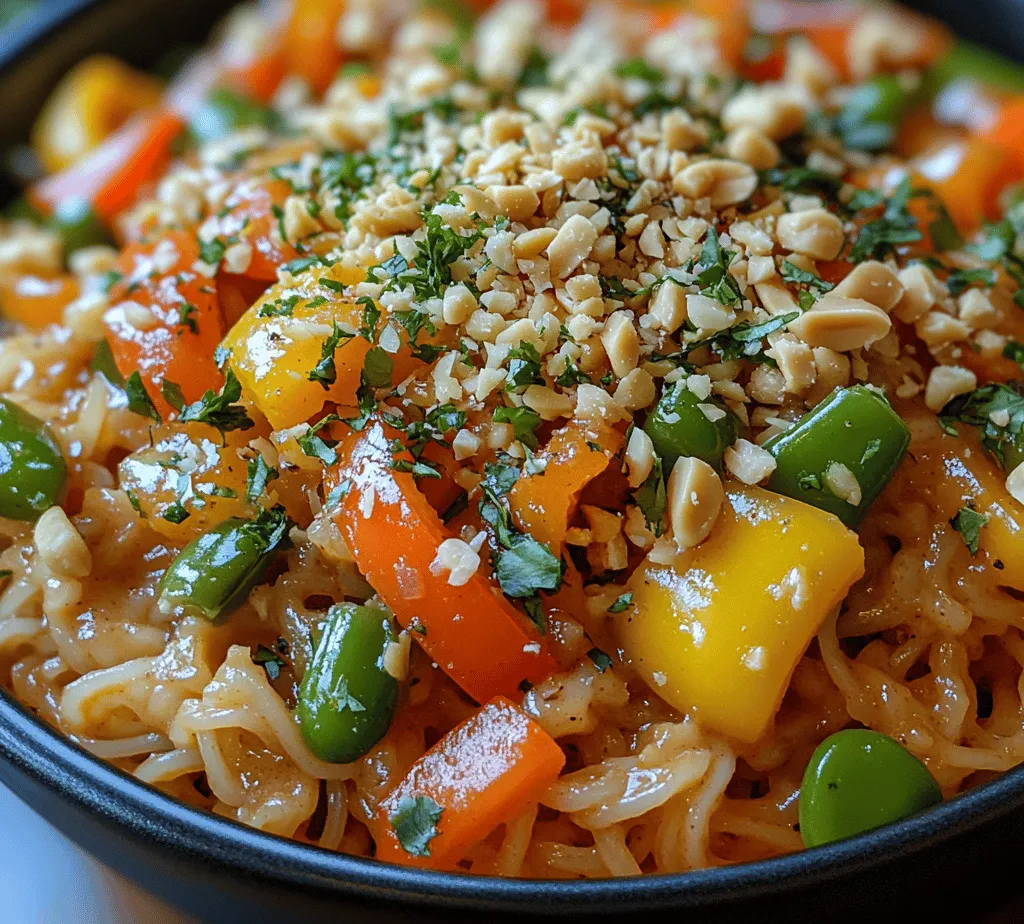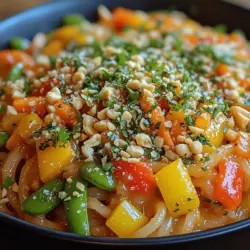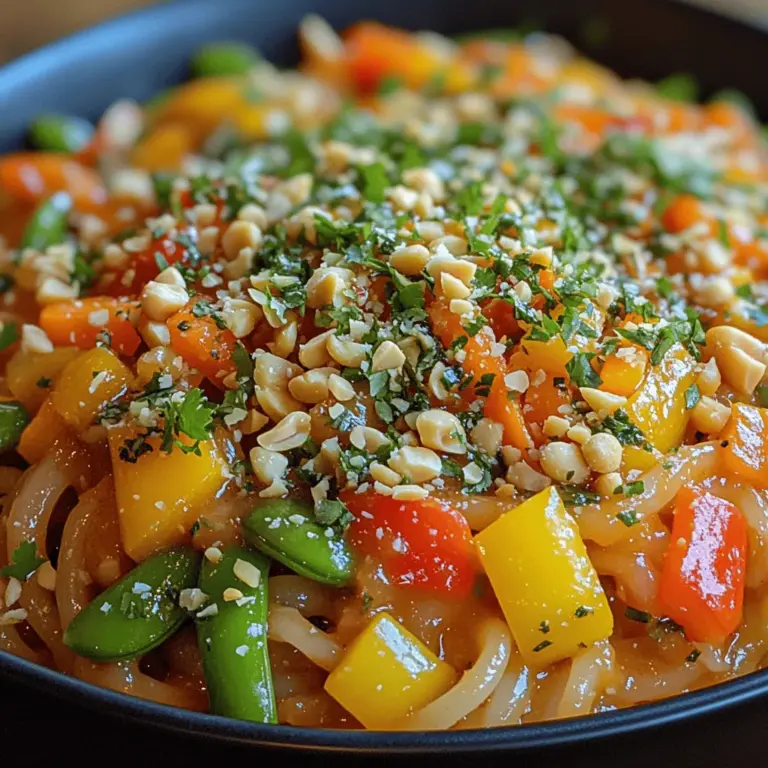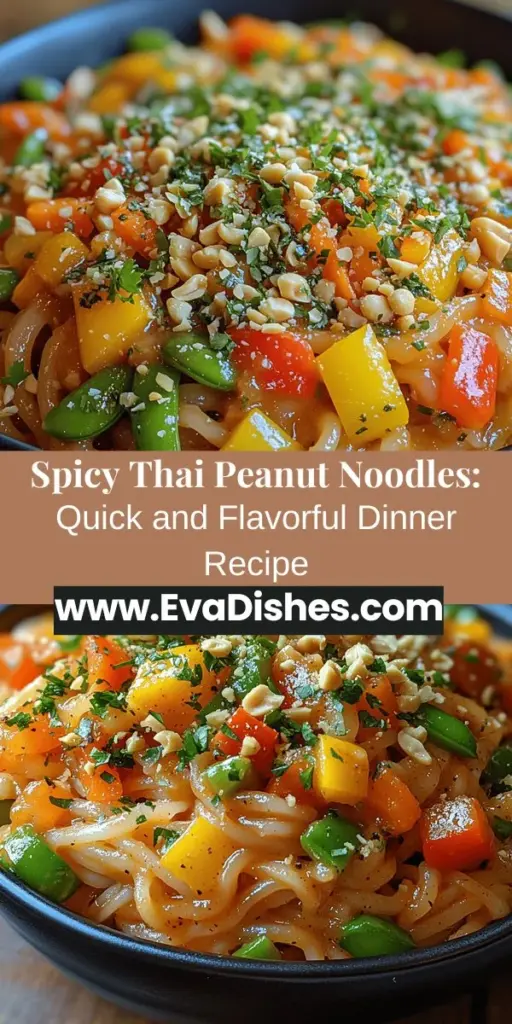Introduction
Discover the vibrant flavors of Thai cuisine with this Spicy Thai Peanut Noodles Delight recipe. Perfect for a quick weeknight dinner or a delightful dish for gatherings, this recipe combines the satisfying texture of rice noodles with a creamy, spicy peanut sauce and a medley of fresh vegetables. This dish is not just about taste; it embodies the essence of Thai cooking, which emphasizes balance, harmony, and the use of fresh ingredients. In this article, we will explore the ingredients, preparation steps, and the cultural significance of this tantalizing dish, ensuring you have all the knowledge you need to create an authentic and delicious experience in your kitchen.
Thai cuisine is renowned for its intricate flavors and textures, and this Spicy Thai Peanut Noodles Delight is no exception. The dish brings together the nutty richness of peanuts with the lively crunch of vegetables, all enveloped in a luscious sauce that warms the palate. As we delve into the world of Thai cooking, you’ll learn how to master each component of this dish, making it a staple in your culinary repertoire.
Understanding the Ingredients
To achieve the best flavors and textures in your Spicy Thai Peanut Noodles Delight, it’s crucial to understand the ingredients that come together to create this masterpiece. Each component plays a significant role in flavor and nutrition, making it essential to choose high-quality, fresh ingredients.
Exploring Rice Noodles
Types of Rice Noodles
Rice noodles are the heart of this dish, providing a satisfying base that absorbs the flavors of the peanut sauce beautifully. There are several types of rice noodles available, ranging from thin vermicelli to wide flat noodles. For this recipe, you can use medium-width rice noodles, commonly found in many Asian grocery stores. They cook quickly and offer a wonderful chewy texture that complements the creamy sauce.
Nutritional Benefits of Rice Noodles
Rice noodles are a fantastic option for those seeking a gluten-free alternative to traditional wheat pasta. They are made from rice flour and water, making them easily digestible and less likely to cause bloating. Additionally, rice noodles are low in fat and can provide a source of carbohydrates, giving you the energy you need for your busy day. They are often enriched with vitamins and minerals, contributing to a balanced diet.
Substitutions for Gluten-Free Options
If you’re looking for gluten-free options, rice noodles are an excellent choice; however, there are also other alternatives available. For those who want to experiment, consider using zucchini noodles or sweet potato noodles as a fresh, nutritious substitute. These options add unique flavors and textures, keeping the dish light and healthy.
Highlighting Fresh Vegetables
The Role of Bell Peppers in Thai Cuisine
Bell peppers are a staple in many Thai dishes, adding a burst of color and sweetness. They come in various colors, including red, yellow, and green, each offering a slightly different flavor profile. In this recipe, feel free to mix and match bell peppers for a vibrant presentation. Their crisp texture complements the softness of the noodles and provides a satisfying crunch with every bite.
Benefits of Incorporating Snap Peas and Carrots
Snap peas and carrots are not only visually appealing but also enhance the nutritional value of your dish. Snap peas provide a sweet, crisp bite, while carrots add a subtle earthiness and a pop of color. Both vegetables are rich in vitamins A and C, supporting your immune system and promoting healthy skin. Incorporating these vegetables into your Spicy Thai Peanut Noodles Delight not only boosts the dish’s flavor but also adds a variety of textures that make each mouthful exciting.
The Importance of Herbs Like Cilantro and Green Onions
Fresh herbs are essential in Thai cooking, bringing brightness and freshness to the dish. Cilantro, known for its distinct aroma, enhances the peanut sauce’s nutty flavors, while green onions provide a mild onion taste that elevates the overall dish. These herbs are best added just before serving to retain their vibrant colors and flavors, ensuring that each bite is a refreshing delight.
Analyzing the Peanut Sauce
Peanut Butter: Creamy vs. Chunky
The star of this dish is undoubtedly the peanut sauce. The choice between creamy and chunky peanut butter can significantly affect the texture and flavor of the sauce. Creamy peanut butter creates a smooth, velvety sauce that clings perfectly to the noodles, while chunky peanut butter adds delightful bits of peanuts, enhancing the dish’s crunch factor. The choice ultimately depends on your personal preference, but both options will yield a delicious result.
The Balance of Flavors: Salty, Sweet, and Spicy
One of the hallmarks of Thai cuisine is the balance of flavors, and achieving this in your peanut sauce is key. A well-crafted sauce combines salty soy sauce, sweet brown sugar or honey, and the heat of chili paste or sriracha. This trifecta of flavors creates a harmonious blend that elevates the dish from ordinary to extraordinary. Experimenting with the ratios of these ingredients will allow you to tailor the sauce to your taste preferences, ensuring that it perfectly complements the noodles and vegetables.
Tips for Adjusting Spice Levels According to Preference
Not everyone enjoys the same level of heat, so it’s essential to customize your peanut sauce to suit your taste. Start with a small amount of chili paste or sriracha, gradually increasing the quantity until you reach your desired spice level. Remember, you can always add more heat, but it’s challenging to tone it down once it’s mixed in. Additionally, serving some extra chili paste on the side allows each person to adjust the spice to their liking.
Step-by-Step Instructions
Now that you’re familiar with the ingredients, it’s time to dive into the preparation process. The following steps will guide you through making your Spicy Thai Peanut Noodles Delight, ensuring that you achieve the perfect balance of flavors and textures.
Preparing the Noodles
Cooking Rice Noodles: Tips for Perfect Texture
Begin by cooking the rice noodles according to the package instructions. Typically, this involves soaking the noodles in hot water for about 10-15 minutes, or until they become tender but still retain a slight bite. It’s crucial not to overcook them, as they will continue to soften when mixed with the peanut sauce.
To achieve the perfect texture, consider using a timer to ensure you don’t exceed the recommended cooking time. Once cooked, drain the noodles and set them aside, allowing them to cool slightly while you prepare the sauce and vegetables.
Rinsing and Cooling: The Science Behind Stopping the Cooking Process
After draining the noodles, rinse them under cold water. This step is essential for stopping the cooking process and preventing the noodles from becoming mushy. Rinsing also helps to remove excess starch, which can make the noodles clump together. Once rinsed, toss the noodles lightly with a drizzle of oil to keep them separated until you’re ready to serve.
Making the Peanut Sauce
Combining Flavors: A Detailed Look at Each Ingredient
To make the peanut sauce, gather your ingredients: peanut butter, soy sauce, lime juice, honey or brown sugar, and chili paste. In a mixing bowl, combine these ingredients, whisking them together until smooth.
Start with the peanut butter as your base, then add soy sauce for saltiness, lime juice for acidity, and honey or brown sugar for sweetness. Finally, incorporate the chili paste to introduce heat. The key to a successful peanut sauce is to mix thoroughly, ensuring that every ingredient is well integrated.
Achieving the Right Consistency: Troubleshooting Common Issues
The consistency of your peanut sauce should be creamy yet pourable. If your sauce is too thick, add a small amount of warm water or coconut milk to thin it out. Conversely, if it’s too thin, incorporate a bit more peanut butter to thicken it up. Taste the sauce as you go, adjusting the flavors to suit your palate.
If you find the sauce too salty, balance it out with additional lime juice or a touch more sugar. It’s all about finding that perfect harmony of flavors that will elevate your dish.
Sautéing the Vegetables
Once your noodles are prepared and your peanut sauce is ready, it’s time to sauté the vegetables. Heat a tablespoon of oil in a large pan or wok over medium-high heat.
Add sliced bell peppers, snap peas, and shredded carrots to the pan, stirring frequently to ensure even cooking. Sauté the vegetables until they are tender but still crisp, retaining their vibrant colors and nutritional benefits. This process usually takes about 3-5 minutes, depending on the heat level and the size of your vegetable pieces.
As the vegetables cook, the aromas will fill your kitchen, enhancing your anticipation for the dish to come.
By understanding the ingredients and following these initial preparation steps, you will set a solid foundation for your Spicy Thai Peanut Noodles Delight. The next part of this article will delve into combining everything to create a stunning, flavorful dish that will impress and satisfy anyone at your table. Stay tuned for the continuation of this culinary journey.



